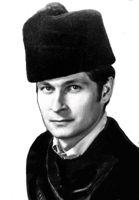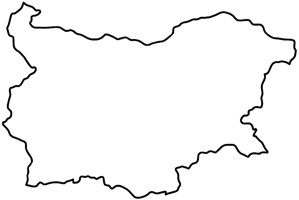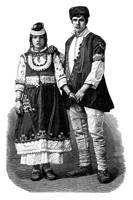
|
The Society of Folk Dance Historians (SFDH)
How I Annoyed Bulgarian
[
Home |
About |
Encyclopedia | CLICK AN IMAGE TO ENLARGE |

|
 In 1964, I went to Bulgaria for the first time. Since then I've probably visited all parts except the Rhodope Mountains, with an extensive look at villages in the Šopluk region, Pirin, Thrace, and in the North from Čumen to Pleven, including along the Danube River. I found dances that delighted me which I've hardly ever taught to folk dancers, and I still have field recordings from my first trip that I haven't released.
In 1964, I went to Bulgaria for the first time. Since then I've probably visited all parts except the Rhodope Mountains, with an extensive look at villages in the Šopluk region, Pirin, Thrace, and in the North from Čumen to Pleven, including along the Danube River. I found dances that delighted me which I've hardly ever taught to folk dancers, and I still have field recordings from my first trip that I haven't released.
One day in 1962 while I was a student at the University of California Berkeley, I had a call from the Mandala folk dance club. A Bulgarian man was there who didn't speak much English, but needed some help getting around the Bay Area and was looking for an American who understood some Bulgarian. So I went over and met him. He was a photographer named Konstantin. We started dancing. I knew a couple of steps of the Četvorno Horo. He said, "In my village we do it this way," and showed me another step. I took him out to dinner and offered to drive him around San Francisco. I didn't realize that a lot of other people wouldn't have taken the trouble. He said, "If you ever come to Bulgaria, write me a note, or send me a telegram, and I will come to meet you." Well, I knew people on tours say these things and often don't come through with them. But I was planning on going to Yugoslavia and told him that. He said, "Send me a wire from Yugoslavia when you are ready to visit my country."
In 1964, after I had been in Yugoslavia for about a year, I thought it was time to go to Bulgaria. I sent a wire from Belgrade to Konstantin and caught the train to Sofia. At the station in Sofia, while I was marveling at all the new sights and savoring my first impressions of a country quite in contrast to the one I had just left, a long black limousine pulled up. A chauffeur in a cap called out to me in Bulgarian, "Are you Mr. Dennis Boxell? Come here, please, one moment." The back door of the limousine opened. Long shapely legs in nylons slipped out. It was a beautiful blonde.
She said, in perfect British, "Hello, Dennis. I'm your interpreter, Natasha. Konstantin sent us to pick you up." Could this delegation have been sent by a lonely peasant from a Shope village? "Where is he now?" I asked. "He sends his regrets," she said. "He couldn't come himself because of important Government business. You see, he is the Minister of Education and is kept very busy with his official duties." I was astonished. She went on, "He'll see you, he'll see you in a day or so, we'll set up an appointment. But please, first we must take you to your hotel." I climbed into the limousine, and they took me to the Rila Hotel, the great luxury hotel in Sofia at that time, and brought me to the penthouse suite. I said, "My goodness, I didn't expect all this from the cup of coffee I bought Konstantin and the little driving I did for him. I only wanted to thank him for the Četvorno he showed me." They said, "Here's your schedule." I said, "What?" They said, "Your schedule for the next two weeks, Mr. Boxell. You'll have Bulgarian language lessons every morning at ten. At noon, you'll go to lunch at famous folklore restaurants, listening to the best kaval, gaida, and gudulka players, enjoying our finest folk singers. Then a nap in the afternoon, or if you prefer, time to shop in our bazaars. In the evening, on the first night, the Maiakovski Ensemble; second night, Koutev Ensemble – all the folklore troupes of Sofia, plus a little trip to Blagoevgrad, Macedonia, for the Pirin Ensemble, one of our best."
It was quite a schedule those first two weeks, and I was thinking it was very good of them. Yet still coming, after all that, was the "Ten Day Grand Tour," to visit remote parts of the country. Several interesting folklore areas throughout North Bulgaria (the village of Dragoevo near Šumen) and in Thrace (the villages of Petrovo and Opan near Stara Zagora), the Valley of Roses and even the Rila Monastery. Chauffeured, hotels paid for, everything done and provided by the Slavjanski Komitet. I was flabbergasted. I was twenty-four years old, and all these things were lavishly being given to me as the only American to befriend a lonely Šop traveling through our land. I never forgot what that one small gesture of mine meant to a man from a Balkan country. Hospitality is tremendously important to them.
So my two weeks in Sofia began. But as these people escorted me from dance group to dance group, I couldn't conceal the disappointment from my face. They asked, "Isn't this wonderful? These are our best ensembles. Isn't this what you came to Bulgaria for?" I said, "I'm so sorry. You certainly are wonderful to me, and these shows are so beautiful, and the dancers are so talented" – and they were talented, the groups were marvelous for talent and skill and overall dance ability – "but it's not what I came to Bulgaria for." "What," they said, "what?" "Well, no," I said. "There's something missing in my heart. I want to see village people dancing, to music by typical Bulgarian instruments. I don't want to hear 101 gudulkas or 50 gaidas playing all at once. That isn't the sound I love. I'd be happy with one accordion and a drum, thank you, or one gajda and tâpan. Or a small band with clarinet, or violin lead." "Well, we don't have that," they said. "We have Grand Art." This went on all through those first two weeks until we hit the Grand Tour.
 After we had met with and seen the Pirin Ensemble, I was even more miserable. By that time, they thought I was crazy. "If you don't like these Macedonians . . .! They're the best we've got!" So they started calling ahead. "Change the plans! He doesn't want to see the State Folk Ensemble, or the People's Wine Bottling Plant. He wants to go to a village wedding." They were on the phone constantly. I was prodding them. "Well, do you have any weddings happening? We have this guest here. He wants to see a wedding. He wants to see folklore events. Do you have any people in costumes? You don't? Well, put them in costumes. We're coming in four hours and we want the whole village in costumes, celebrating something or other, we don't care what." So I finally got to see villagers. The first stop was outside Stara Zagora, in Thrace. Some of them, especially women, still wore their costumes as daily attire. The whole village dressed up and re-enacted part of a wedding for me. Then, as long as they were dressed up, they danced. The whole village performed with great gusto a Pravo Trakijsko and at the end, the men separated from the women and broke into a Često, powerfully intense and delightful to watch. That was wonderful.
After we had met with and seen the Pirin Ensemble, I was even more miserable. By that time, they thought I was crazy. "If you don't like these Macedonians . . .! They're the best we've got!" So they started calling ahead. "Change the plans! He doesn't want to see the State Folk Ensemble, or the People's Wine Bottling Plant. He wants to go to a village wedding." They were on the phone constantly. I was prodding them. "Well, do you have any weddings happening? We have this guest here. He wants to see a wedding. He wants to see folklore events. Do you have any people in costumes? You don't? Well, put them in costumes. We're coming in four hours and we want the whole village in costumes, celebrating something or other, we don't care what." So I finally got to see villagers. The first stop was outside Stara Zagora, in Thrace. Some of them, especially women, still wore their costumes as daily attire. The whole village dressed up and re-enacted part of a wedding for me. Then, as long as they were dressed up, they danced. The whole village performed with great gusto a Pravo Trakijsko and at the end, the men separated from the women and broke into a Često, powerfully intense and delightful to watch. That was wonderful.
My hosts grew impatient and very annoyed with me and this village stuff. They were, after all, members of the Communist Party, and they were trying to show off the most impressive accomplishments of their modern Communist state. They were disappointed in me. They tried hard to take me to steel mills and factories. I was only happy with peasants. They would sit in the car bored and anxious to move on while I eagerly explored each new village we visited. They were so unhappy. My beautiful blonde interpreter pouted. "This is disgusting, these villages. We don't understand why you've come so far, from a great country like America, to see these peasants dancing around in their simple surroundings with their crude, coarse ways. We want to leave right now for the luxury hotel in Stara Zagora, with the red plush carpeting and classic European dining next to the night club and bar, and get some real food."
At the moment, we were at the most exciting wedding I had ever been to. I was sitting at the men's table parallel to another long table set up for the women. Bread was being brought to me – home-made bread. It smelled so good. There was čorba, a great big goulash-type soup. Roast chicken. Lamb. Rice pilaff. Šlivovica. No one makes Šlivovica like the Thracians – the most golden, wonderful plum brandy in the world. And wines, with their rich tastes. Real food? I was beside myself. I said to Natasha, "No, I don't want to leave." "You're impossible, Dennis! You're the most unpleasant guest we've ever had! We're thinking of canceling the tour and returning to Sofia immediately! We can't stand these villages any more!" I let them sit and pout, and I went back to the raucous sounds of Thracian clarinet, violin, accordion, and drum. The wedding party was enjoying a wild Kyuček in 9/16 rhythm and I joined them. But right then and there I made up my mind to come back later on my own. Fortunately, after the tour, I was able to stay in Bulgaria for three more months. And yes, I did go back.
The excitement for me, then and on my later trips, was seeing what people did for their own entertainment. They loved spectacle. I'm using the word in the French sense – a gala event with lots of colors and music and food. They loved to dress up, have a big festival, put on all the old-time costume pieces. They were amazed to find an American like me who was interested in the costumes. I had done my homework in the museums, so I knew the right questions to ask. "What about that little bracelet the girls used to wear?" They were delighted. "You know about that?" And they'd rush to their trunks to dig one out and put it on so I could see the right way to wear them.
I wanted to understand each area I went to. I wanted to learn all the dances of Thrace, all the dances of Šop-land. After that, I went up to Pleven and got a big surprise seeing the Vlach and Romanian dances up there. Those are dances like Čerkeska and Kamenopolsko and Čekurjankino. The versions of those three dances that I later taught are just arrangements of village dance steps edited to fit the recorded music. One reason I love to have live music for teaching, as a University of Chicago festival gave me in 1990 and an Atlanta, Georgia, festival did in 1999, is that you can understand better how the dance works: dancing each step as long as you like and then signaling the musicians to go on, either slowing or speeding up the tempo.
In Thrace, the great dances are Rŭčenica – done all over Bulgaria – Pravo Trakijsko, Paiduška, Trite Pŭti. From Stara Zagora to Sliven, and south to Haskovo and Topolovgrad, is where they do Često. Everyone is dancing the Pravo, and after a while, as the music grows faster, the men break out of the line, come forward, and start fancy tapping steps. Around Sliven there are many variations of Trite Pŭti. Throughout Bulgarian Thrace and down into Greek Thrace (as in much of Southeast Europe, Thrace is an ethnic region that political boundaries run through; another part of Thrace is today in Turkey), they love a dance called Kyuček, in 9/8. Greek Thracians call it Syngathistos, because it is danced in couples. Around 1923, Greeks in Thrace were resettled into political Greece. I became especially interested in them in 1985 because of the work I had begun to do with the U.S. Greek community. Anyway, no Thracian wedding would be complete without that dance. It can get raucous. Thracians use their arms and hands in very tasty ways.
The Šopluk borders on Serbia and Macedonia. The Serbs have a certain looseness of the upper body that Bulgarians don't. The "natrisané," or trembling of the body which so many people associate with Šops, mainly appears in their local step that Bulgarian dance teachers call Šopka. The Šops also enjoy a variety of unusual rhythms, like 13/16 for the dance Petrunino, 11/16 for Kopanica, or the amazing 25/16 for the dance Sedi Dimka (7+7+11) and, of course, Rŭčenica in 7/16. A basic dance form that Šops share with Macedonians is called Graovsko on the Bulgarian side and Kopačka on the Macedonian. They start to fancy it up. They add such embellishments that, before long, we don't recognize it. All the little places are completely filled in with hop-step-steps and twizzles and twinkles, especially as the music grows faster. That's very exciting and one of the reasons people are attracted to Shope and Eastern Macedonian dance.
Actually I found more things in common than different throughout the Balkans. It's true the costumes are different, and each region has its own dances, its own style and idiom, its favorite songs and melodies. But we magnify the differences in grotesque ways. We should be studying the basics, the things in common. Then to enjoy dancing like a Thracian, or like a Šop, would be much easier for us. I've definitely found that true with performing groups.
It's very interesting trying to put folk dances on the stage. I met the famous choreographer Kiril Haralampiev in Bulgaria. In the early days he had what I consider the right philosophy. You learn dances from the village. You perform village steps and you maintain the village idiom. Even though villagers might not do all those dances together or quite such complex combinations, your work is at most to amplify or concentrate. It is as if you put on the best saint's–day dance or wedding ever, with all the best dancers and musicians there. The stage should display the dances, not distort them. Seventy per cent of the impact comes from the traditional village dance style and technique – how they are done; thirty per cent from how you edit and frame them.
Everything has to be based thoroughly on the village. In Bulgaria, as is the case elsewhere, not everyone has understood this. Instead it was, "I'll go to choreography school and study geometric figures. Those villages are dirty and the villagers are simpletons anyway." Fantasy became popular. And of course with State performing troupes, many people joined them for political and personal reasons more than from taking delight in the traditions. The curious thing is that while I keep hearing how this fantasy approach pleases audiences, it doesn't last. In today's language we might say it isn't good ecology; it may bring a rush of energy, but you can't live on it. I've had great artistic satisfaction, and won applause and prizes, by teaching folk dancers and performing groups to be as authentic as I can. They tell me they have more fun that way, and I do too.
DOCUMENTS
- Bulgaria, a country.
- Dennis Boxell, an article.
A similar version of this article appeared in a 1991 issue of the Folk Dance Federation of California, South, magazine "Folk Dance Scene."
This page © 2018 by Ron Houston.
Please do not copy any part of this page without including this copyright notice.
Please do not copy small portions out of context.
Please do not copy large portions without permission from Ron Houston.